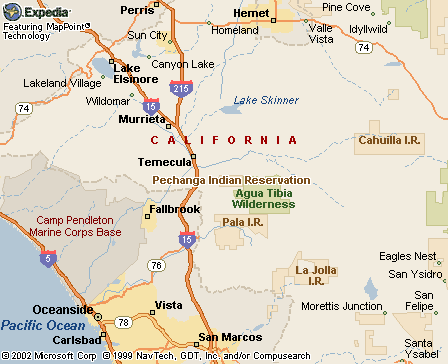|
|
Canku Ota |
|
|
(Many Paths) |
||
|
An Online Newsletter Celebrating Native America |
||
|
October 5, 2002 - Issue 71 |
||
|
|
||
|
Indian Runners Stop at Pechanga Ancient Oak |
||
|
by Tim O'Leary The
Press Enterprise
|
||
|
credits: Steve Thornton/North
Country Times Staff Photographer
|
 PECHANGA
RESERVATION - Smoke from burning sage, fanned by eagle feathers, drifted
among the massive limbs of the Pechanga tribe's sacred Great Oak south
of Temecula at dawn Tuesday. PECHANGA
RESERVATION - Smoke from burning sage, fanned by eagle feathers, drifted
among the massive limbs of the Pechanga tribe's sacred Great Oak south
of Temecula at dawn Tuesday.
Hands rubbed the rough bark of the sun-dappled oak as songs and prayers welcomed runners who embarked last week on a 700-mile journey aimed at winning Gov. Davis' signature on hotly debated legislation that could be used to protect such sacred Indian sites throughout California. "I believe that our churches are right here," said Phil Emerson, a 48-year-old council member of the Quechan Nation, a Colorado River tribe that is trying to block Glamis Imperial Corp. efforts to dig for gold on federal land near its reservation. "We feel very strongly about what we do." Alongside Emerson and other Quechan members participating in the "Spirit Run" were officials from the Pechanga tribe. They also praised Senate Bill 1828, which has drawn opposition from builders in Inland Southern California and elsewhere. Ancient oak's meaning Assemblyman Bill Leonard, R-San Bernardino, who shepherded the measure through the Assembly, used the story of the 2,000-year-old oak to make his case. The Pechanga tribe has been fighting a proposal by San Diego Gas & Electric to erect a power line through southwestern Riverside County. The power line would pass near the ancient oak, which is not on the tribe's federally protected reservation but on a ranch owned by the tribe. "It's always been used as a gathering spot," said John Gomez, a Pechanga member who has worked to protect tribal cultural resources. "It's nurtured the people. The people have nurtured it." Some of the runners said the tree, thought to be the largest of its kind in the state, gave them power to ease the aches and pains that have come from running through mountain passes and deserts. Numbering about 35 people, some as young as 8 years old, and led by a core group called the "Buffalo Runners," the Quechan members began their trek Friday on the steps of the state Capitol. They have exceeded 150 miles some days and expect to reach their Winter Haven destination about Thursday. They plan to return to the tribe's "stomping ground," an area where a fire has been tended since they left. After Tuesday's ceremony, members of both tribes said all eyes are on Davis. They have launched an intensive lobbying effort, making telephone calls and writing e-mails detailing the need for the bill introduced by state Sen. John Burton, D-San Francisco. What bill calls for A tribe could lodge an objection to the project. The local agency would have final approval over the project, according to the bill, but could overrule a tribe's objection only if there is an "overriding environmental, public health or safety reason" that the project should proceed. Critics fear that overcoming such a hurdle added to the state's Environmental Quality Act would be virtually impossible, and passage of the bill would give tribes nearly complete authority over development. Some builders have criticized the measure as unconstitutional and potentially crippling. They fear development projects could become embroiled in lawsuits and the bill could be abused if tribes exaggerate a site's religious significance. "It's kind of scary," said Jerry Swanger Sr., a San Diego-based developer whose efforts to plan commercial buildings near a Luiseno cemetery east of Temecula have been fought by Pechanga officials. "It absolutely makes no sense whatsoever." Swanger, who said he supports most Indian issues and voted for legalized gambling on reservations, said the bill would give one religion preference over others. Laura Miranda, a Pechanga member and a lawyer, said Indian leaders have repeatedly tried to allay fears that passage of the bill would give tribes broad powers to halt projects or give sacred designations to areas that have not been recognized by the state. Thousands of important Indian sites have been lost to development throughout the Inland region and elsewhere in the state, Miranda said. Safeguards are needed to protect the remaining religious sites, she said. "We think it's a good balance," she said.
|
|
|
||
|
|
||
| Canku Ota is a free Newsletter celebrating Native America, its traditions and accomplishments . We do not provide subscriber or visitor names to anyone. Some articles presented in Canku Ota may contain copyright material. We have received appropriate permissions for republishing any articles. Material appearing here is distributed without profit or monetary gain to those who have expressed an interest. This is in accordance with Title 17 U.S.C. section 107. | ||
|
Canku Ota is a copyright © 2000, 2001, 2002 of Vicki Lockard and Paul Barry. |
||
 |
 |
|
|
The "Canku Ota - A Newsletter Celebrating Native America" web site and its design is the |
||
|
Copyright © 1999, 2000, 2001, 2002 of Paul C. Barry. |
||
|
All Rights Reserved. |
||
